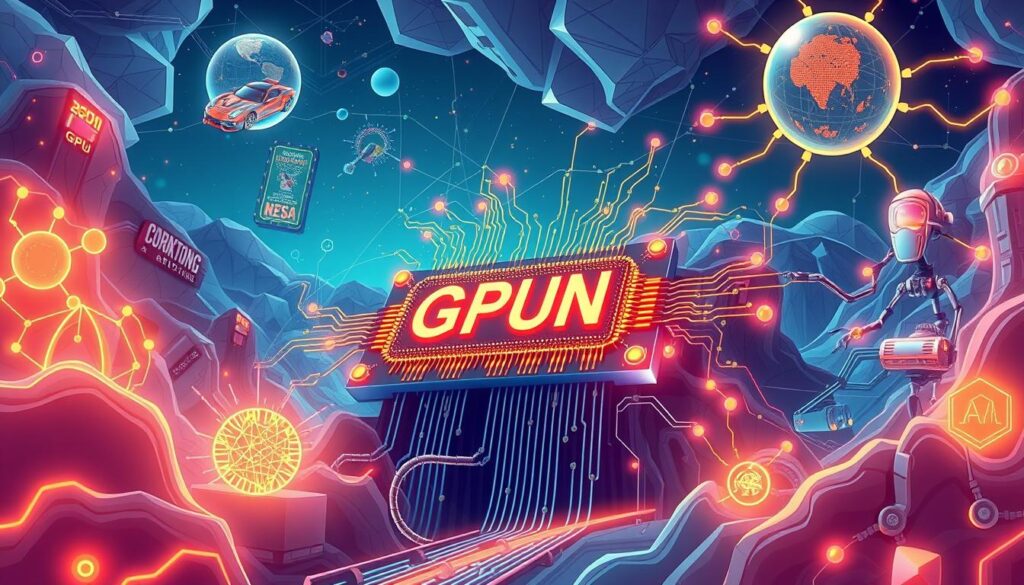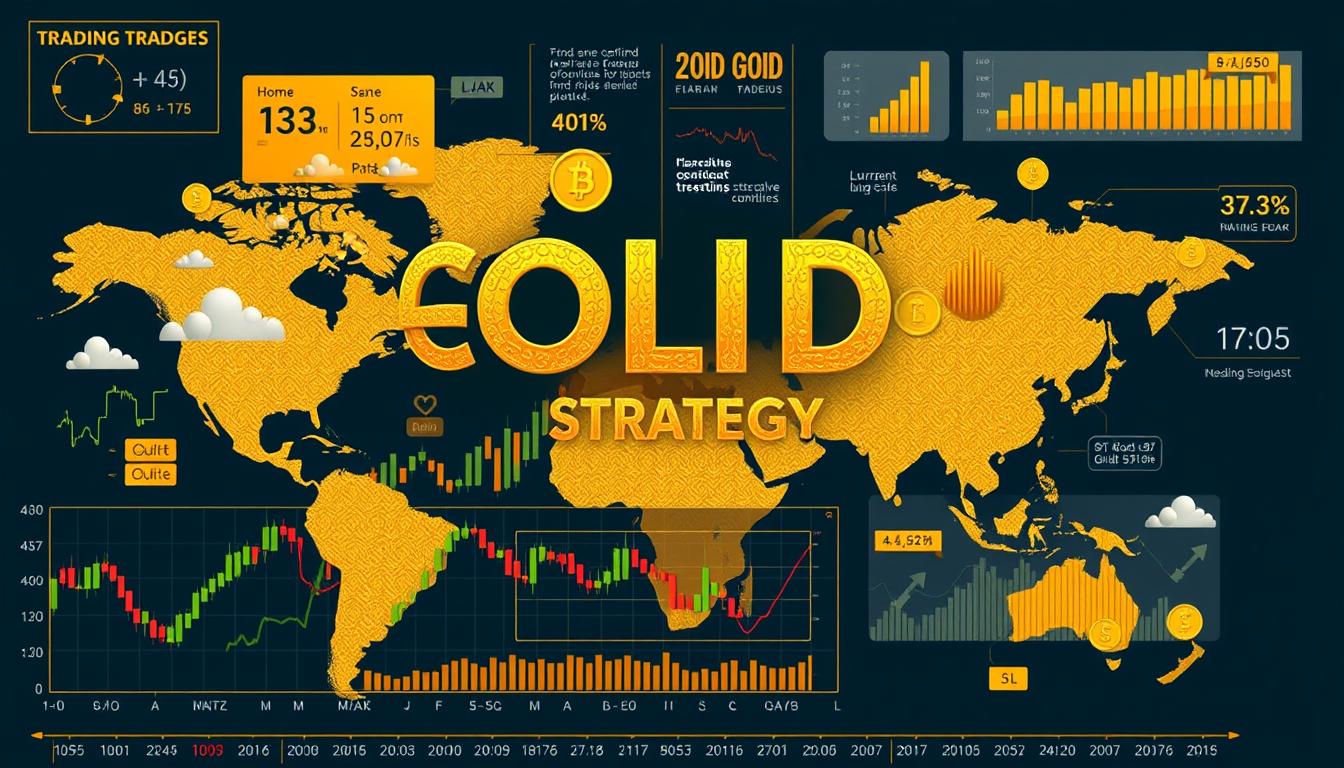The graphics processing unit (GPU) has become key in the rise of artificial intelligence (AI). It started as a tool for gamers to see better graphics. Now, it’s at the heart of AI, making things that were once science fiction real.
Nvidia, started in 1993 by Jensen Huang, Chris Malachowsky, and Curtis Priem, led this change. They released the GeForce 256 in 1999 and CUDA in 2006. These moves made Nvidia a leader in AI.
Nvidia’s value has skyrocketed, hitting over $2 trillion. It’s now among the biggest tech companies. This shows how powerful GPU-accelerated AI is. It’s changed fields like image recognition and natural language processing.
Key Takeaways
- Nvidia’s journey from a 3D graphics card company to an AI powerhouse
- The development of the world’s first GPU, the GeForce 256, in 1999
- The release of CUDA in 2006, which revolutionized the use of GPUs for parallel computing
- The pivotal role of GPUs in enabling breakthroughs in AI technologies
- Nvidia’s meteoric rise in market valuation, reaching over $2 trillion
The Birth of GPU Technology: From Denny’s to Silicon Valley Success
Nvidia’s story is one of humble beginnings and extraordinary vision. In 1993, Jensen Huang, a former dishwasher at a Denny’s restaurant, co-founded Nvidia alongside two friends in a small office in San Jose, California. This unassuming start would soon transform into a global powerhouse, reshaping the landscape of computing and artificial intelligence (AI).
Jensen Huang’s Journey and Early Vision
Huang, a Taiwanese immigrant, was fascinated with computer graphics and parallel processing. He and his co-founders aimed to create a company that would revolutionize the industry. Despite initial setbacks, Huang’s vision and persistence led Nvidia to join the S&P 500 just eight years after its founding.
The First GPU Breakthrough: GeForce 256
Nvidia’s first major breakthrough came in 1999 with the GeForce 256. It was the world’s first GPU with programmable CUDA cores. This chip transformed the PC gaming market and set the stage for Nvidia’s future success in CUDA cores and deep learning hardware.
Overcoming Initial Setbacks
Nvidia faced many challenges early on. Their first product, the NV1, failed, putting the company at risk. But Huang and his team showed resilience, pivoting to focus on the Riva 128 chip. This led to the success of the GeForce 256.
Nvidia’s journey from a small start-up to a technology giant is inspiring. Today, its CUDA cores and deep learning hardware lead the AI revolution. They power some of the most advanced applications worldwide.
GPU Revolution in AI: A Paradigm Shift in Computing
The rise of GPU-accelerated neural networks has changed the AI world. NVIDIA’s GPUs, once for gaming, now power AI and machine learning. They handle parallel processing tasks with ease.
As AI models got more complex, we needed more computing power. NVIDIA’s GPUs were the answer, providing the speed for AI’s big data needs. Geoffrey Hinton’s 2012 image recognition work showed this, using NVIDIA’s GPUs for amazing results.
NVIDIA’s GPUs are now key in AI, making the company a leader. These solutions are vital for training and running AI models. They help researchers and businesses keep up with AI’s fast pace.
| Metric | Improvement |
|---|---|
| Training Time | Up to 6x faster for large AI models |
| Inference Latency | Significant reduction |
| Energy Efficiency | Improved in data centers hosting AI workloads |
The GPU revolution in AI has sped up innovation and opened new doors. It’s changed fields like computer vision and natural language processing. As demand for GPUs grows, platforms that offer easy, affordable access will shape AI’s future.
“The GPU revolution has been a game-changer for AI, unlocking new possibilities and driving unprecedented advancements in the field.”
Understanding CUDA: The Foundation of AI Acceleration
CUDA is at the core of Nvidia’s success in AI computing. It’s a platform and toolkit that changes how developers use Nvidia GPUs. CUDA’s design makes quick work of complex math, boosting AI and machine learning in many fields.
Parallel Processing Architecture
GPUs are faster than many CPUs because of their design. They can handle tasks much quicker. CUDA lets developers break down big problems into smaller ones, making use of Nvidia’s GPUs for faster work.
Developer Ecosystem and Tools
The CUDA community is growing, drawing more AI developers to Nvidia. Red Hat OpenShift Data Science (RHODS) makes it easier to use CUDA with Kubernetes. RHODS lets users pick PyTorch and TensorFlow for their work, making GPU use easier.
Impact on Deep Learning Development
CUDA has greatly influenced deep learning. In 2011, Nvidia GPUs started speeding up deep neural networks. The 2012 ImageNet competition showed Nvidia’s power, with AlexNet beating traditional software.
By 2015, Google and Microsoft beat human ImageNet scores with deep learning. This was a big win for AI and Nvidia’s GPUs.
Nvidia’s CUDA has made the company a leader in GPUs. It keeps Nvidia’s system closed, driving sales and quality. CUDA’s growth is fueled by innovation and more developers joining.
From Gaming Graphics to AI Powerhouse
NVIDIA started as a gaming company but became a leader in AI. This change shows how innovation and planning can transform a business. They began with GeForce graphics cards that changed 3D gaming. Now, they lead the GPU Revolution in AI.
In 2006, NVIDIA introduced CUDA, showing their vision for using GPUs in AI and data analysis. As AI needs grew, NVIDIA shifted focus from gaming to AI research. This move made them a key player in the AI world.
NVIDIA’s GPUs, like Pascal and Volta, were made for AI work. They help in AI research and use in industries. Technologies like Torch-TensorRT and AMP make NVIDIA GPUs powerful for AI tasks.
NVIDIA’s focus on AI has paid off financially. By June 2024, its value hit $3 trillion, making it the most valuable company. Revenue and profits have soared, showing investors believe in NVIDIA’s future.
NVIDIA is key in AI innovation, like building AI supercomputers. They helped OpenAI with the first AI supercomputer in 2016. This was crucial for ChatGPT. They also work on autonomous vehicles with the Drive platform.
NVIDIA’s shift to AI shows their vision and tech skills. As AI needs grow, NVIDIA will keep leading in AI acceleration. They will shape the future of computing and innovation.
Nvidia’s Role in Modern AI Development
Nvidia is leading the charge in artificial intelligence (AI). Their work in parallel computing and Tensor Processing Units (TPUs) makes them crucial in AI. They power many groundbreaking innovations across different fields.
Data Center Innovation
Nvidia has teamed up with big names like Google, Amazon, and Microsoft. Together, they create powerful GPUs for AI workloads. This partnership helps businesses and researchers work on AI projects faster and more efficiently.
AI Supercomputing Breakthroughs
Nvidia is always pushing AI boundaries. In March 2024, they introduced the Blackwell GPU. These AI supercomputers handle tough tasks for AI models. They help in areas like natural language processing and drug discovery.
Partnership with Tech Giants
Nvidia’s tech is used by top companies and startups. They use it for things like weather prediction and virtual movie sets. Nvidia’s GPUs and SDKs are key to these innovations, changing industries and shaping tech’s future.
| Metric | Value |
|---|---|
| Nvidia’s ARM shares (as of February 2024) | 1.96 million |
| Nvidia’s Recursion Pharmaceuticals shares (as of February 2024) | 7.7 million |
| Nvidia’s Soundhound AI shares (as of February 2024) | 6.6 million |
| Nvidia’s Nano-X Imaging shares (as of February 2024) | 59,000 |
| Nvidia’s market value ranking (as of March 2024) | 3rd largest American company |
Nvidia’s drive for innovation and partnerships with tech leaders make it a key player in AI. As AI needs grow, Nvidia’s skills in Tensor processing units and parallel computing will be vital for future AI breakthroughs.
Real-World Applications of GPU-Accelerated AI
The rise of deep learning hardware and GPU-accelerated neural networks has opened up a new world of AI innovation. It’s changing many industries. From predicting the Earth’s weather to changing movie making, GPU AI is making a big impact.
One big use is in simulating global weather patterns. Now, it’s 3,000 times faster than old supercomputers. Thanks to Nvidia GPUs, we can predict extreme weather better and faster. This helps keep communities and buildings safe.
In movies, Nvidia GPUs are changing how virtual sets are made. Cuebric shows how these GPUs can create very real digital places. This makes movie making faster and opens up new ideas for filmmakers.
The healthcare field is also seeing big changes with GPU AI. At Generate:Biomedicines, Nvidia GPUs help find new proteins to fight diseases like cancer and asthma. This speeds up finding and making new medicines.
Also, GPU AI is changing robotics. Figure, a robotics company, is making humanoid robots. These robots will be tested in BMW’s factory in South Carolina. This could make factories more efficient and automated.
These examples show how deep learning hardware and GPU-accelerated neural networks are changing many fields. They’re making things like weather prediction, movie making, and medical research better.
| Application | Industry | GPU Impact |
|---|---|---|
| Weather Simulation | Climate and Environment | 3,000x faster computations than traditional supercomputers |
| Virtual Movie Set Creation | Entertainment | Realistic digital environments for film production |
| Protein-based Drug Development | Healthcare | Accelerated discovery and development of novel therapeutics |
| Humanoid Robot Testing | Robotics and Manufacturing | Enhanced automation and efficiency in factory settings |
These uses of GPU-accelerated neural networks and deep learning hardware are just the start. AI is changing many areas and opening up new scientific and technological areas.
The Future of AI Hardware: Beyond Traditional GPUs
The need for more powerful and efficient AI is growing fast. The industry is looking into new solutions that go beyond traditional GPUs. Next-generation AI chip architectures are being developed, promising to change how we do AI computations.
Next-Generation Architecture
Big tech companies and research groups are working on new chip designs. They aim to beat traditional GPUs in AI tasks. These new chips, like Tensor processing units (TPUs) and neuromorphic chips, are designed for AI. They hope to bring better efficiency, speed, and scalability to AI.
Emerging Technologies and Integration
New technologies like quantum computing and photonic processing are also on the horizon. These could lead to faster and more energy-saving AI. As these technologies get better, we’ll see AI in more places, like self-driving cars and smart cities.
Sustainability and Energy Efficiency
There’s also a big push for sustainable and energy-efficient AI hardware. The growing environmental impact of data centers is a big worry. The industry is working on ways to make AI computing better for the planet. Ideas include better cooling systems and using renewable energy.
The future of AI hardware looks bright. With new chip designs and emerging technologies, we’re on the path to more powerful and sustainable AI. This will shape the future of technology in exciting ways.
“The future of AI hardware might rely on chips thinking more like human brains, promising a new era of AI that’s faster, more efficient, and aligned with biological brains’ abilities.”
The industry is always looking to push the limits of what’s possible. By combining the latest hardware and software, we’re on the verge of a new era of AI. This AI will be more advanced, sustainable, and meet our changing needs.
Technical Innovations and Industry Impact
The GPU revolution has led to huge leaps in AI computing power. NVIDIA’s unique tech has given it a big edge in AI and machine learning. This has changed the game for the company.
NVIDIA keeps making GPUs better and creating special AI hardware. This has sped up deep learning and AI model progress. Their NVIDIA AI platforms are key for AI experts and developers. They help push AI’s limits.
NVIDIA’s Omniverse AI platform is a big deal. It lets people make digital twins, work together better, and improve simulations. This is great for healthcare, cars, and climate studies, where accurate models and fast data analysis are key.
NVIDIA and others are tackling AI’s risks and job loss worries. They aim to make AI’s benefits clear while avoiding its downsides. They’re focusing on AI that works with humans, not against them.
The future of AI hardware looks even brighter. New architectures and tech are coming. These innovations will change many areas of life and work, solving big global problems.
“NVIDIA’s continuous innovation in GPU design and the development of AI-specific hardware have been instrumental in accelerating the progress of deep learning and other AI models.”
Conclusion
Nvidia’s journey from a gaming graphics leader to an AI giant is truly remarkable. Their work on GPUs has changed AI technology across many fields. This shows their vision and innovation.
Jensen Huang’s leadership has pushed Nvidia to new heights. They use parallel processing to make big strides in AI. This includes CUDA, Tensor Cores, and memory tech advancements.
The need for fast AI processing is growing fast. Nvidia is at the forefront, helping with big data and new tech like self-driving cars. They’re committed to making AI better and are leading the way to a new AI era.






